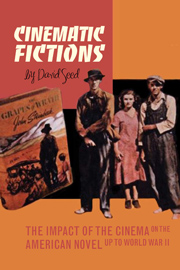Book contents
- Frontmatter
- Contents
- Introduction
- 1 Beginnings
- 2 Modernist Experiments: Gertrude Stein and Others
- 3 H.D. and the Limits of Vision
- 4 Ernest Hemingway: The Observer's Visual Field
- 5 Success and Stardom in F. Scott Fitzgerald
- 6 William Faulkner: Perspective Experiments
- 7 John Dos Passos and the Art of Montage
- 8 Dreiser, Eisenstein and Upton Sinclair
- 9 Documentary of the 1930s
- 10 John Steinbeck: Extensions of Documentary
- 11 Taking Possession of the Images: African American Writers and the Cinema
- 12 Into the Night Life: Henry Miller and Anaïs Nin
- 13 Nathanael West and the Hollywood Novel
- Bibliography
- Index
6 - William Faulkner: Perspective Experiments
- Frontmatter
- Contents
- Introduction
- 1 Beginnings
- 2 Modernist Experiments: Gertrude Stein and Others
- 3 H.D. and the Limits of Vision
- 4 Ernest Hemingway: The Observer's Visual Field
- 5 Success and Stardom in F. Scott Fitzgerald
- 6 William Faulkner: Perspective Experiments
- 7 John Dos Passos and the Art of Montage
- 8 Dreiser, Eisenstein and Upton Sinclair
- 9 Documentary of the 1930s
- 10 John Steinbeck: Extensions of Documentary
- 11 Taking Possession of the Images: African American Writers and the Cinema
- 12 Into the Night Life: Henry Miller and Anaïs Nin
- 13 Nathanael West and the Hollywood Novel
- Bibliography
- Index
Summary
Like Hemingway, William Faulkner initially deploys quasi-cinematic methods to represent the processes of perception, but he also pursues experiments with the interplay between limited perspectives. Throughout the 1930s his novels make progressively more and more reference to film in their representational methods. Particularly since the 1970s, a considerable body of criticism has been built up on William Faulkner's relation to the cinema and most of his screenplays, even those for television, have now been published. Claude-Edmonde Magny concludes his study The Age of the American Novel with a chapter discussing Faulkner's use of witnesses to establish point of view, reversal of chronology and other features of what he calls a ‘film aesthetic’. Edward Murray finds cinematic principles working behind Faulkner's use of cross-cutting (The Sound and the Fury) and flashbacks (Light in August); Alan Spiegel focuses on Sanctuary as the textual embodiment of Hollywood in its subject, but also in its ‘mode of expression: melodramatic, typological, hyperbolic’. The most general explanation of the cinematic dimension to Faulkner has been given by Bruce Kawin, who argues that repetition and montage are central to his works.
Faulkner became actively involved in screenwriting from 1931 and the following year he paid his first visit to Hollywood, registering astonishment at the impermanence and unreality of the place. Thereafter he had regular working spells throughout the 1930s and 1940s for MGM, Twentieth Century-Fox and Warner Brothers.
- Type
- Chapter
- Information
- Cinematic FictionsThe Impact of the Cinema on the American Novel up to World War II, pp. 107 - 127Publisher: Liverpool University PressPrint publication year: 2009



